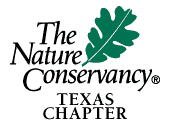|
| |  From the Winter '99, Volume 24, No. 3 Issue of Horizon From the Winter '99, Volume 24, No. 3 Issue of Horizon
by Niki Frances Mc Daniel
Horizons Editor
Reprinted by permission of The Nature Conservancy of Texas, copyright 2000
For the birds: Partners conserve
nesting grounds on beautiful Shamrock Island
Protected from the winds and waves of the Gulf of
Mexico by Mustang Island, Shamrock
Island Preserve in Corpus Christi Bay is a hurricane-created refuge that
includes sand and shell beaches, inter-tidal wetlands, an interior seagrass
lagoon and vegetated beach ridges.
Shamrock was a barrier spit before its connection to Mustang Island was severed
during Hurricane Celia in 1971. The breaking of the land bridge limited predator
access, allowing the island to become one of the most important colonial bird
nesting islands on the Texas coast.
As many as 21 bird species, including the threatened reddish egret and
white-faced ibis, nest on the 110-acre island. Gull-billed, Sandwich, Caspian
and royal terns nest on the high-quality beach habitat; in some years, royal
terns number close to 8,000, making Shamrock by far the most important nesting
site for this species on the Texas coast. Black skimmers also use the shell
beach sites, while the more vegetated shell-hash flats provide nesting habitat
for up to 6,000 laughing gulls. On the beach ridges vegetated by salt cedar,
nesting species include great blue herons, little blue herons, tricolored
herons, black-crowned night herons, great egrets, snowy egrets, reddish egrets,
white-faced ibis and roseate spoonbills. The sooty tern, which nests only rarely
in Texas, also nests at Shamrock Island.
Through a partnership developed with the Texas General Land Office in 1995, The
Nature Conservancy of Texas acquired Shamrock Island and now manages it as a
preserve. Another important partner is the present oil and gas operator on the
island, Bristol Resources Corporation. Together, Bristol and the Conservancy
cleaned up and restored a portion of the island damaged by past oil and gas
extraction. Bristol Resources also installed a docking facility, where the
Conservancy keeps the Miss Shamrock, a 17-foot boat essential for island access
and research as well as for patrolling, protecting and maintaining the island
preserve.
However, the work of preserving Shamrock Island is far from complete. A recent
study showed that the island was rapidly losing ground to erosion. Vulnerable to
winter northers, the northwest shoreline lost 515 feet between 1956 and 1995.
This erosion also threatens to breach the island, which could degrade the
interior lagoon and result in the loss of valuable bird habitat. Moreover, if
this process continues, crucial seagrasses will be unprotected from bay
currents, and the increasing turbidity could damage seagrass habitat or cause it
to disappear altogether. Protecting seagrass beds is imperative: Texas coastal
wetlands serve as nursery grounds for more than 95 percent of the recreational
and commercial fish species found in the Gulf of Mexico.
To address the island's rapidly eroding northwestern boundaries, a joint
shoreline restoration project was mounted by The Nature Conservancy with a host
of partners, including the Texas General Land Office, Texas Parks and Wildlife
Department, the Coastal Bend Bays Foundation, Texas Audubon Society and private
businesses and individuals. Completed in February 1999, this project
successfully installed a sand-filled "geotube" of heavy synthetic
cloth -- 4,600 feet long and five feet in diameter -- to brace the north and
west sides of the island.
In addition, 90,000 cubic yards of sand were pumped from the island's submerged
neck and spread along 650 feet of the northwest shore to create a "feeder
beach" - so called because this supply of sand will replenish the shoreline
along the southern portion of the island. Without this shoreline stabilization,
the island would continue eroding unabated.
Still more work remains to be done, according to Jim Bergan, South Texas Program
Manager and overseer of the island's erosion and restoration project, noting
plans for a series of volunteer events on the island to plant cordgrass to
create a marsh area for additional protection against erosion on the island's
northwest side. To prepare for the planting, a five-acre area between the shore
and geotube has been filled with 10,000 cubic yards of sand. To avoid disturbing
nest birds, the marsh creation project is being carried out during the
non-nesting season between September, 1999 and February 15, 2000. Further
planting will continue in September, 2000.
The Nature Conservancy of Texas has initiated various outreach and education
programs involving Shamrock Island. Local high school and grade school science
classes have conducted projects on the island, while teacher workshops and
Elderhostel projects have used the island preserve as a living laboratory.
Besides reducing erosion, the project will protect and restore island and
wetland habitat for nesting birds, including several endangered and threatened
species. In addition, restored seagrass beds will benefit the local economy,
where sport fishing currently nets $83 million and birdwatching brings in $4.6
million annually. The project will also enhance water quality in Corpus Christi
Bay, trapping residual seepage of hydrocarbons from oil and gas operations in
vegetation that naturally converts this potentially toxic material into less
harmful forms.
Finally, this project will provide a valuable model for other wetland protection
and restoration efforts by the U.S. Fish and Wildlife Service, the Texas Parks
& Wildlife Department, the Texas General Land Office, the Corpus Christi Bay
National Estuary Program, and other public and private groups in the Corpus
Christi Bay area.
|
 From the Winter '99, Volume 24, No. 3 Issue of Horizon
From the Winter '99, Volume 24, No. 3 Issue of Horizon